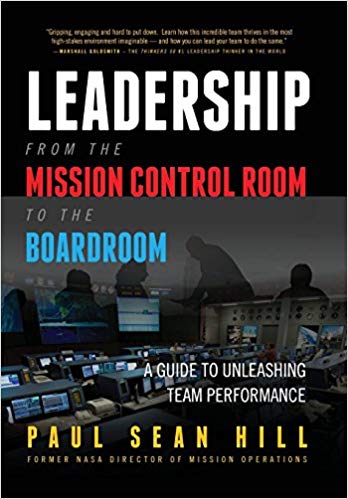Leadership from the Mission Control Room to the Boardroom
by Paul Sean Hill
 Review by Patti Blackstaffe
Review by Patti Blackstaffe
If you read one book in 2018*, please read this one, especially if you have a leadership position and are tasked with leading change!
Mission Control Challenges Are Leadership Challenges
The author describes some of the key challenges faced by NASA and Mission Control and they certainly apply to leading in an organization, specifically to leading transformation and change. His key focus:
- Developing mastery, dealing with time constraints, decision making, protecting a legacy, addressing the human element
Paul Hill tells his audiences, that no matter how often he talks about leadership, it always boils down to values and culture. In his book Leadership from the Mission Control Room to the Boardroom, Paul shares the kind of leadership guidance that allowed NASA to execute with precision and flawless accuracy. He is not simply asserting an opinion on how to lead, but demonstrates what has proven to work within a complex and life-or-death environment, and how it can work for your organization too.
If you lead a company, where a solid technical foundation is the basis of your business, then this book is for you! You CAN create a great team and still achieve cost efficiency by following the strategies and tactics in the book, believe me, it will be worth your while.
Why would a Transformation and Change Person Recommend this book?
As I moved through the book, I could not help but notice how so many strategies that organizational change and development research tells us are vital are what made Mission Control so successful. It solidified for me the value of taking the time and applying the resources to the fundamentals of how addressing the human factor can be applied well to business.
One of the reasons this is so important to the leader is that getting out of the bottom-line spreadsheets and developing teams that all share a core purpose and are able to meet team performance not only saves wasted dollars, but it supports the mission.
He describes how NASA’s Mission Control success was more than the rocket science, more than the math – success meant pulling a team together.
When Leaders Lead Transformation or Change
Leaders have a responsibility to stand by a moral code, demonstrate that moral code, and insist on the morality in business. Easier said than done, but Paul demonstrates how an alignment to a purpose and other elements can help leaders develop, share, and uphold the morality of an organization.
Without giving too much away – one phrase that stood out for me was “fly the way you train” (and train the way you fly). Think about that for a minute…Murphy’s Law says, if anything can go wrong, it usually does go wrong sooner or later! Knowing how to deal with situations that arise is often specific to how well trained your team is, and how they respond to the situation based on their training. Paul provides some great reasons to make sure your staff is well-trained and how that training must be aligned with how you do your business.
I was thrilled to see him discuss awareness, alignment, and transparency because this is a process we use with our clients through every transformation project. Paul’s stories and examples provide ample ways to support responsibility, accountability, intent, and honesty through the mission. Asking people to join the mission, align with a core purpose, and ensure behaviours of every member of the team work cohesively can be a leader’s greatest challenge.
The bulk of the topics align closely with the necessary ‘people strategy’ that researched Organizational Development and Organizational Change Management adhere to.
Additional Thoughts
In the layout of the book, each chapter provides a quick summary of the chapter points and he goes on to make recommendations, this provides one with a book-mark-and-check-back option of putting key post-it tabs where the summary is rather than having you go back to read the book. I like this because time is always of the essence and leaders need quick reference options.
Finally, points of interest!
- Salient Points that are tactical, pragmatic, and highlight the reason for their importance.
- He clearly describes what success looks like in a highly complex life-or-death environment by introducing us to Mission Control.
- The stories give us insight into Mission Control and the inner workings showing us the foundation for ‘getting it right’.
- Paul clearly lays out the path to success with relevance as it applies to the boardroom and leadership of any large organization.
Clearly, I liked the book and am considering providing it to the lead sponsor as a starting point for the transformation efforts we take on. Do I recommend it? Yes, I do.
*Disclaimer: I was sent a free copy of this book for review, however, I do not receive any payment for the writing of this article and I am free to provide an honest and truthful review.
[PostFooterPB]
